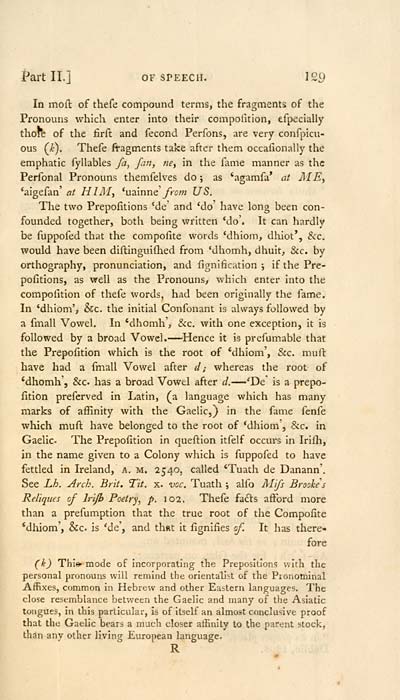Download files
Complete book:
Individual page:
Thumbnail gallery: Grid view | List view

Part II.] OF SPEECH. 12y
In moft of thefe compound terms, the fragments of the
Pronouns which enter into their compolition, efpecially
thore of the firft and fecond Perfons, are very confpicu-
ous (ir). Thefe fragments take after them occalionally the
emphatic fyllables fa, fan, ne, in the fame manner as the
Perfonal Pronouns themfelves do ; as 'agamfa* at MEy
*aigefan' at HI My *uainne'yic;w US.
The two Prepofitions Me' and 'do' have long been con-
founded together, both being written *do'. It can hardly
be fuppofed that the compofite words 'dhiom, dhiot', &c.
would have been diftinguiflied from 'dhomh, dhuit, &c. by
orthography, pronunciation, and fignification j if the Pre-
pofitions, as well as the Pronouns/ which enter into the
compofition of thefe words, had been originally the fame.
In 'dhiom', &c. the initial Confonant is always followed by
a fmall Vowel. In 'dhomh', &c. with one exception, it is
followed by a broad Vowel. — Hence it is prefumable that
the Prepofition which is the root of 'dhiom', &c. muft
have had a fmall Vowel after d ; whereas the root of
*dhomh', &c. has a broad Vowel after d. — 'De* is a prepo-
fition prefcrved in Latin, (a language which has many
marks of afiinity with the Gaelic,} in the fame fenfe
which mufì: have belonged to the root of 'dhiom', &c. in
Gaelic. The Prepofition in queftion itfelf occurs in Irilli,
in the name given to a Colony which is fuppofed to have
fettled in Ireland, a, m. 2540, called 'Tuath de Danann'.
See Lh. Arch. Brit. Tit. x. voc. Tuath j alfo Mifs Brookes
Reliques of Irifb Poetry, p. 1 02, Thefe fadts afford more
than a prefumption that the true root of the Compofite
*dliiom', &c. is 'de', and that it fignifies of. It has there-
fore
(k) Thi*' mode of incorporating the Prepositions with the
personal pronouns will remind the orientalist of the Pionotninal
Affixes, common in Hebrew and other Eastern languages. The
close resemblance between the Gaelic and many of the Asiatic
tongues, in this particulai", is of itself an almost conclusive proof
that the Gaelic bears a much closer affinity to the parent stock,
than any other living European language.
R
In moft of thefe compound terms, the fragments of the
Pronouns which enter into their compolition, efpecially
thore of the firft and fecond Perfons, are very confpicu-
ous (ir). Thefe fragments take after them occalionally the
emphatic fyllables fa, fan, ne, in the fame manner as the
Perfonal Pronouns themfelves do ; as 'agamfa* at MEy
*aigefan' at HI My *uainne'yic;w US.
The two Prepofitions Me' and 'do' have long been con-
founded together, both being written *do'. It can hardly
be fuppofed that the compofite words 'dhiom, dhiot', &c.
would have been diftinguiflied from 'dhomh, dhuit, &c. by
orthography, pronunciation, and fignification j if the Pre-
pofitions, as well as the Pronouns/ which enter into the
compofition of thefe words, had been originally the fame.
In 'dhiom', &c. the initial Confonant is always followed by
a fmall Vowel. In 'dhomh', &c. with one exception, it is
followed by a broad Vowel. — Hence it is prefumable that
the Prepofition which is the root of 'dhiom', &c. muft
have had a fmall Vowel after d ; whereas the root of
*dhomh', &c. has a broad Vowel after d. — 'De* is a prepo-
fition prefcrved in Latin, (a language which has many
marks of afiinity with the Gaelic,} in the fame fenfe
which mufì: have belonged to the root of 'dhiom', &c. in
Gaelic. The Prepofition in queftion itfelf occurs in Irilli,
in the name given to a Colony which is fuppofed to have
fettled in Ireland, a, m. 2540, called 'Tuath de Danann'.
See Lh. Arch. Brit. Tit. x. voc. Tuath j alfo Mifs Brookes
Reliques of Irifb Poetry, p. 1 02, Thefe fadts afford more
than a prefumption that the true root of the Compofite
*dliiom', &c. is 'de', and that it fignifies of. It has there-
fore
(k) Thi*' mode of incorporating the Prepositions with the
personal pronouns will remind the orientalist of the Pionotninal
Affixes, common in Hebrew and other Eastern languages. The
close resemblance between the Gaelic and many of the Asiatic
tongues, in this particulai", is of itself an almost conclusive proof
that the Gaelic bears a much closer affinity to the parent stock,
than any other living European language.
R
Set display mode to: Large image | Transcription
Images and transcriptions on this page, including medium image downloads, may be used under the Creative Commons Attribution 4.0 International Licence unless otherwise stated. ![]()
| Early Gaelic Book Collections > Blair Collection > Elements of Gaelic grammar > (161) |
|---|
| Permanent URL | https://digital.nls.uk/79041907 |
|---|
| Description | A selection of books from a collection of more than 500 titles, mostly on religious and literary topics. Also includes some material dealing with other Celtic languages and societies. Collection created towards the end of the 19th century by Lady Evelyn Stewart Murray. |
|---|
| Description | Selected items from five 'Special and Named Printed Collections'. Includes books in Gaelic and other Celtic languages, works about the Gaels, their languages, literature, culture and history. |
|---|

